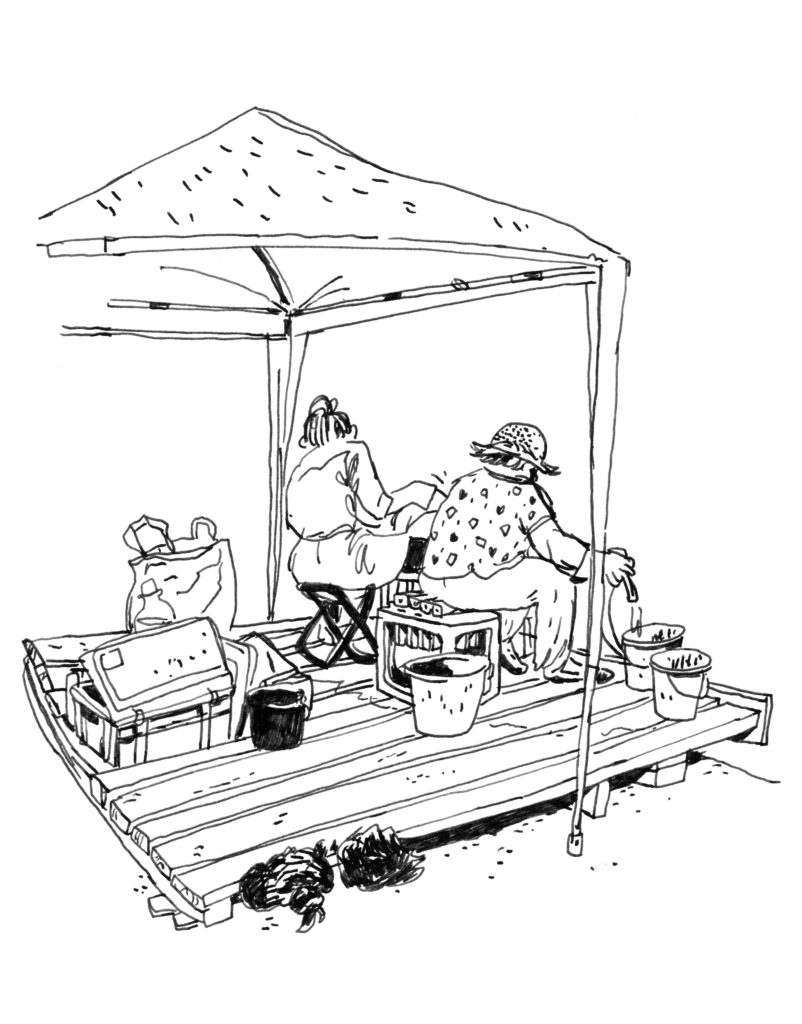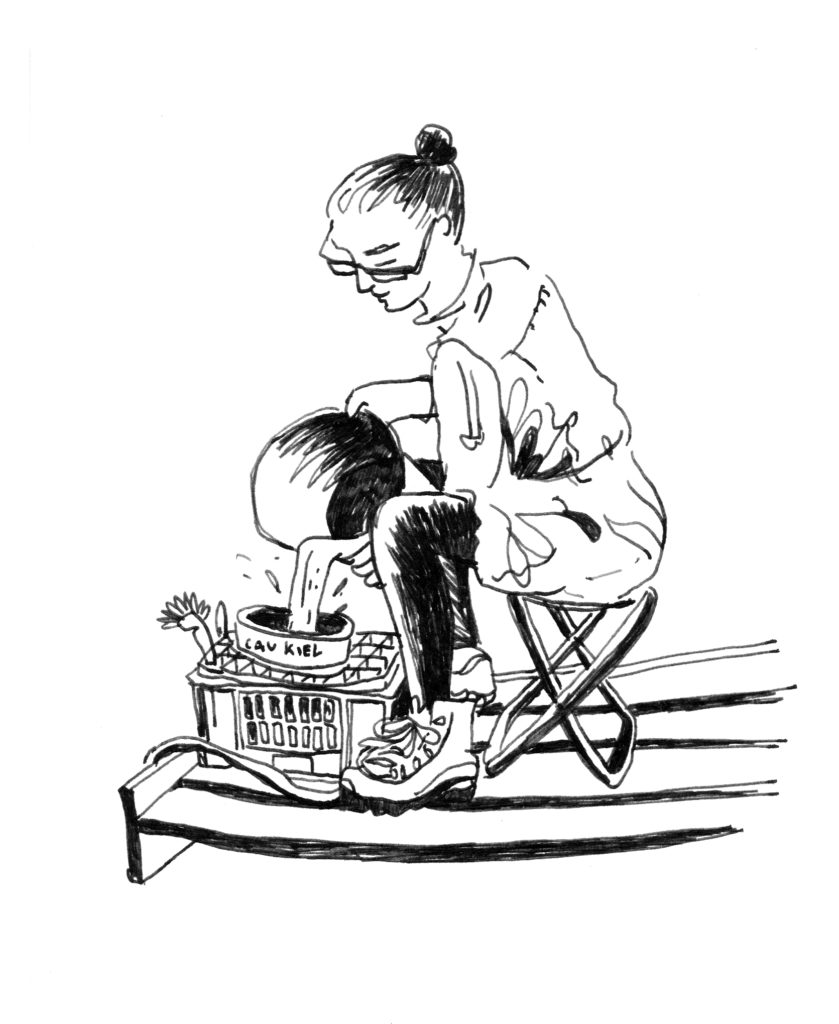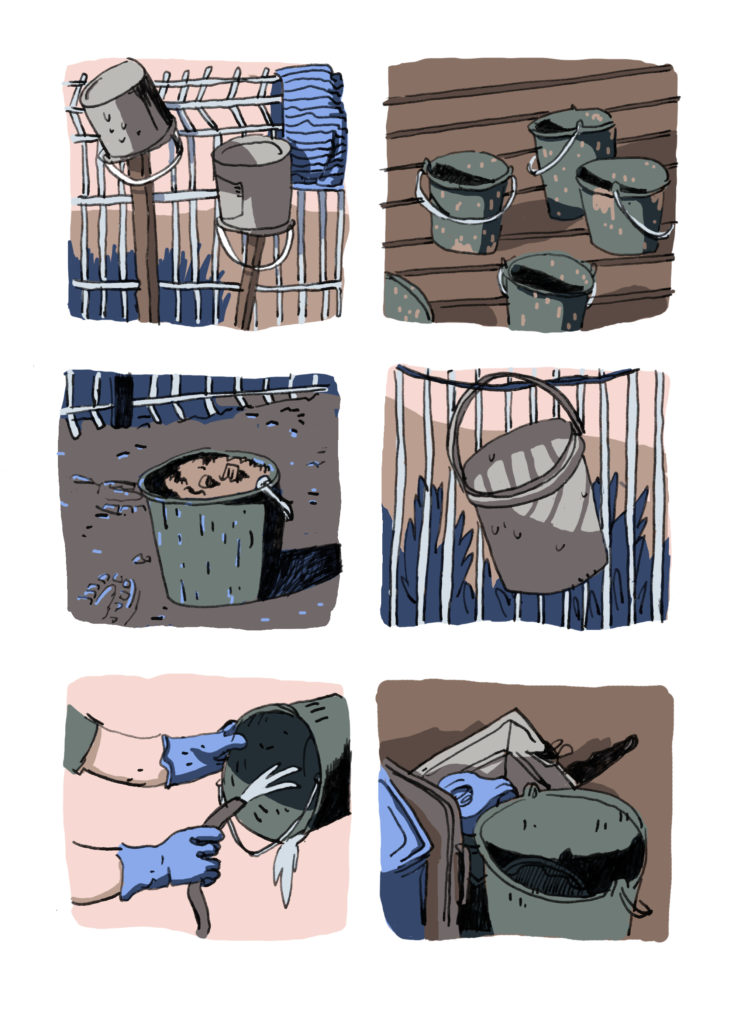Die Sonne steigt schnell. Schwalben zwitschern und flattern tief über dem Wasser hin und her. Die Pumpe brummt kaum hörbar vor sich hin, Wasser plätschert aus dem Schlauch. In der Ferne rumpelt metallisch ein LKW, im Dorf krähen ein paar verspätete Hähne. Die Eimer klappern. Geredet wird noch nicht.
Ich bin hier bei Pia und Svetlana, am „Stolniceni Beach“, wie Marta es nennt. Es wird still geschlämmt. Eine Bodenprobe aus einem der Quadranten eines Schnittes auf der Grabung wird auf fünf Eimer verteilt. Diese Eimer füllt Svetlana mit Wasser und rührt sie dabei mit behandschuhten Händen durch. Nach einer Weile hat sich die Erde, die einen Großteil der Probe ausmacht, gesetzt und oben schwimmt alles, was leicht ist. Gehofft wird auf verbranntes organisches Material, Pflanzenreste. Die drei hier sind schließlich Archäobotanikerinnen.
Was dann oben schwimmt, gießt Pia durch ein Sieb (300 µm), und spült mit dem Schlauch nach. Jeder der fünf Eimer wird nun drei Mal geschlemmt, insgesamtalso 15 Mal für jeden Probe. Was dann noch in dem Sieb übrig ist, wird in Polyesterbeutelchen umgefüllt und zum Trocknen an den Zaun gehängt. Abends wird dann in der Schule umgetütet und schon mal ein Blick auf die Ergebnisse geworfen. „Die Ährenachsen sahen nach hexaploidem Nacktweizen aus“ sagt Pia. Ich stimme ihr zu. Eindeutig hexaploide Nacktweizen-Ährenachsen-Segmente.
Ich habe natürlich keine Ahnung und bin schwer beeindruckt. Als Pia es mir erklärt, verstehe ich immerhin, was Nacktweizen ist. Freidreschend, also ohne Spelzen. Und der spielte laut Marta in Tripolje eigentlich keine Rolle. Da die Probe dazu auch noch aus einer der oberen Grabungsschichten stammt und eine der gefundenen Ährenachsen nicht völlig verkohlt ist, müssen sie damit rechnen, dass sie eher von aktuellerer Beackerung des Feldes stammt. Schade.
Inzwischen ist es 9:00 Uhr. Ich habe ein paar Zeichnungen gemacht, die beiden haben zahlreiche Eimer geleert und gereinigt und der erste Kaffe wird geteilt. Jetzt werden sie auch gesprächiger. „Aber weißt du was, ich träume noch nicht von Eimer“ sagt Svetlana in ihrem warmen weißrussischen Akzent. Das wird schon noch kommen, das Träumen von Eimern.
Schön hier bei euch in Stolniceni Beach.
The sun is rising quickly. Swallows chirp and flutter all over the water. The pump hums tenderly, water patters out of the hose. A truck bumps in the distance, some late cocks crow in the village. The buckets rattle. No talking. Not yet.
I’m with Pia and Svetlana at „Stolniceni Beach“. Well, that’s what Marta calls it. They’re doing floatition. A soil samples gets distributed into five buckets. Svetlana then fills them with water whilst stirring with her gloved hands. After letting it rest for a while, the dirt deposits onto the bottom of the bucket. The lighter contains of the sample float upon the water. They hope for burnt organic remains. They’re Archeobotanists.
Pia pours the water into a sieve (300 µm), trying to keep the dirt inside the bucket. Every bucket gets floatated three times. The adds up to Pia emptying 15 buckets per sample. Everything that remains after that process gets put into a polyester bag for drying. In the evening, during our office hours in school, Pia and Marta transfer them into small paper bags and already take a short look at the samples. „The rachis-segment looks like it might be hexaploid naked wheat“ says Pia. I agree, it’s obviously hexaploid wheat rachis-segments.
Of course I don’t have any clue. After Pia did some explaining, I at least unterstand what „naked wheat“ is. It doesn’t have any husks.
According to Marta, this kind of wheat didn’t play any role during Trypillia. Besides the sample it was found in comes from one of the upper layers of the trench. So it’s rather likely, that it originates from recent farming. What a pity.
The sun has come very far, it’s 9 am now. I’ve made a couple of drawings, the girls emptied a lot of buckets and we share the first coffee. They start getting more communicative. „You now what, I haven’t even started dreaming of buckets“ says Svetlana with her warm belarus accent. She will be dreaming of buckets soon.
Life is better at the beach.





